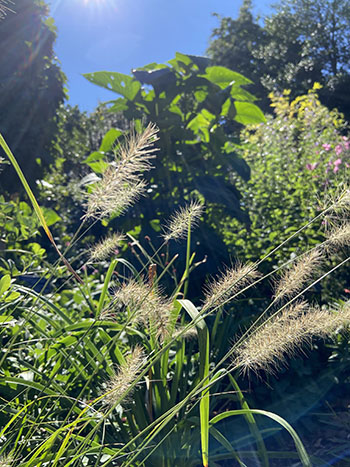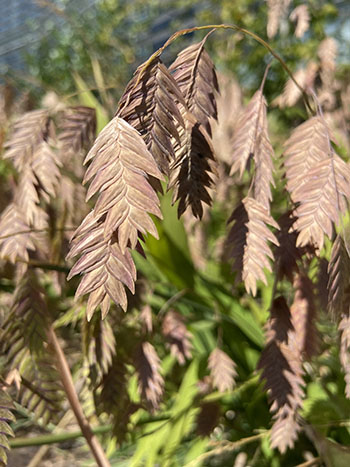
Plants of the Week: October 3

Sporobolus heterolepis (prairie dropseed)
You can smell the Sporobolus heterolepis well before you see it. The scent has been compared to coriander, buttered popcorn, or even hot wax. But for me, if the dry heat of summer had a scent, it would be this. This distinct smell is a result of the branching flower panicles on slender stems rising above the arching foliage of prairie dropseed in August through October.
This ornamental grass is a North American native usually found in prairies, glades, and along railroads. It has fine-textured, medium-green leaves that will turn golden in the fall and bronze in the winter. It is a slow-growing and slow-to-establish plant that is worth the wait, as it is deer, drought, erosion, and air pollution tolerant.
At the Scott Arboretum, Sporobolus heterolepis can be found in the Science Center infiltration beds, planted en masse with Verbena bonariensis (South American vervain) and Bigelowia nuttallii (Nuttall’s rayless-goldenrod) dotted throughout. It grows well here, in its preferred full sun with medium to low moisture. It is an elegant, elevate-your-senses kind of plant and I recommend stopping by to explore what the late-blooms smell like to you. Photo credit: M. Rossman

Pennisetum alopecuroides ‘Hameln’ (fountain grass)
There is just something so elegant about a grass swaying in the breeze, especially when the sun interacts with the plume-like flower heads to create a scene worthy of a landscape portrait. One particular specimen that has been adding said elegance to our gardens here is the Pennisetum alopecuroides ‘Hameln’. Also known as fountain grass, this compact perennial grass forms a clump of dense arching linear leaves. Bright green in the summer, the leaves transition into a golden-yellow during the fall before fading to beige and will remain attractive through the winter.
However, what particularly draws me to this plant are the silvery-white bottle brush like flower spikes that develop in mid- to late-summer. These delicate, soft flowers sit well above the leaves and arch outwards looking as if they are glowing when backlit by the sun. They bloom from August to October and will turn brown as the seeds form, persisting until late fall/early winter before shedding.
The lovely fountain grass can be observed in the Scott Entrance Garden or in the Cut Flower Garden here at the Scott Arboretum and certainly adds a gentle touch to our beds. Photo credit: M. Rossman

Chasmanthium latifolium (northern sea oats)
The new Singer Hall landscape is truly a celebration of Pennsylvania’s bioregions. As you circle around the building you will encounter an array of plants native to areas such as the piedmont meadows or the New Jersey coastal plain mixed oak forests. In many of these demonstrated bioregions you will find a striking and movement-forward grass that is audibly present in the landscape when the breeze blows.
The Chasmanthium latifolium is an ornamental grass that is native to the eastern United States and northern Mexico. It grows in Zones 3-8 and is most distinguished by its flat, dropping seed heads. Forming on arched stems, the seed heads flutter when caressed by even the softest of breezes and emerge green but transition into purplish-broze by late summer.
This is a clump-forming grass that can grow up to a height of 2-5 feet with a spread of 1-2 feet. It prefers medium to wet soil and is one of the more shade tolerant ornamental grasses, but can certainly handle full sun. Those seed heads are not just attractive but they are functional too, as this plant self-seeds and spreads quite a bit. Chasmanthium latifolium usually are present in woods or on rocky slopes along streams or moist bluffs and here at the Scott Arboretum are richly present in the Singer Hall landscape. Photo credit: M. Rossman





No Comments